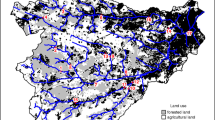Abstract
The Rhine ecosystem is highly influenced by anthropogenic stresses from pollution, intensive shipping and increased connectivity with other large European rivers. Canalization of the Rhine resulted in a reduction of heterogeneity to two main biotopes: sandy streambeds and riverbanks consisting of groyne stones. Both biotopes are heavily subjected to biological invasions, affecting the rivers food web structure. The Ponto-Caspian amphipods, Chelicorophium curvispinum and Dikerogammarus villosus, have exerted the highest impact on this food web. The filterfeeding C. curvispinum dominated the Rhine food web on the stones in 1998, swamping the stone substrata with mud. However, in 2001 it decreased in numbers, most likely due to top-down regulation caused by increased parasitic and predatory pressure of other more recently invaded Ponto-Caspian species. D. villosus showed a fast population increase after its invasion and particularly influenced the macroinvertebrate community on the stones by predaceous omnivory. This species seemed to have maintained its predatory level after its population established. Effects of these mass invaders on the macroinvertebrate community of sandy streambeds in the Rhine are unclear. Here, low densities of macroinvertebrates were observed with the Asiatic clam, Corbicula fluminea, as most abundant species. Stable isotope values of food webs from the stones and sand in 2001 were similar. Aquatic macrophytes are nearly absent and the food web is fuelled by phytoplankton and particulate organic matter, originating from riparian vegetation as indicated by similar δ13C values. Omnivores, filter-, deposit-, and detritus-feeders are the primary and secondary macroinvertebrate consumers and function as keystone species in transferring energy to higher trophic levels. Invaders comprise 90% of the macroinvertebrate numbers, and can be considered ecosystem engineers determining the functional diversity and food web structure of the Rhine by either bottom-up or top-down regulation.
Similar content being viewed by others

References
W. Admiraal G. Velde Particlevan der H. Smit W. G. Cazemier (1993) ArticleTitleThe rivers Rhine and Meuse in the Netherlands: present state and signs of ecological recovery Hydrobiologia 265 97–128
W. Admiraal L. Breebaart G. M. J. Tubbing B. Zanten Particlevan E. D. Ruijter van Steveninck Particlede R. Bijkerk (1994) ArticleTitleSeasonal variation in composition and production of planktonic communities in the Lower River Rhine Freshwater Biology 32 519–531
A. Bij de Vaate A. Klink (1995) ArticleTitleDikerogammarus villosus Sowinsky (Crustacea: Gammaridae), a new immigrant in the Dutch part of the Lower Rhine Lauterbornia 20 51–54
A. Bij de Vaate M. B. A. Swarte (2001) ArticleTitleDendrocoelum romanodanubiale in the Rhine delta: first records from The Netherlands Lauterbornia 40 53–56
A. Bij de Vaate K. Jazdzewski H. A. M. Ketelaars S. Gollasch G. Velde Particlevan der (2002) ArticleTitleGeographical patterns in range extension of Ponto-Caspian macroinvertebrate species in Europe Canadian Journal of Fisheries and Aquatic Sciences 59 1159–1174 Occurrence Handle10.1139/f02-098
Bij de Vaate, A. 2003. Degradation and Recovery of the Freshwater Fauna in the Lower Sections of the Rivers Rhine and Meuse. PhD Thesis, University of Wageningen, Wageningen
A. Bij de Vaate R. Breukel G. Velde Particlevan der (2006) ArticleTitleLong-term developments in ecological rehabilitation of the main distributaries in the Rhine Delta: fish and macroinvertebrates Hydrobiologia 565 229–242 Occurrence Handle10.1007/s10750-005-1916-4
G. Cabana J. B. Rasmussen (1996) ArticleTitleComparison of aquatic food chains using nitrogen isotopes Ecology 93 10844–10847 Occurrence Handle1:CAS:528:DyaK28XmtVOlu70%3D
J. A. Crooks (2002) ArticleTitleCharacterizing ecosystem-level consequences of biological invasions: the role of ecosystem engineers Oikos 97 153–166 Occurrence Handle10.1034/j.1600-0706.2002.970201.x
C. Hartog ParticleDen F. W. B. Brink Particlevan den G. Velde Particlevan der (1992) ArticleTitleWhy was the invasion of Corophium curvispinum and Corbicula species so successful? Journal of Natural History 26 1121–1129
M. J. DeNiro S. Epstein (1978) ArticleTitleInfluence of the diet on the distribution of the carbon isotopes in animals Geochimica et Cosmochimica Acta 42 495–506 Occurrence Handle1:CAS:528:DyaE1cXls1WrsbY%3D Occurrence Handle10.1016/0016-7037(78)90199-0
M. J. DeNiro S. Epstein (1981) ArticleTitleInfluence of the diet on the distribution of the nitrogen isotopes in animals Geochimica et Cosmochimica Acta 45 341–351 Occurrence Handle1:CAS:528:DyaL3MXktVGmtLw%3D Occurrence Handle10.1016/0016-7037(81)90244-1
J. T. A. Dick I. Montgomery R. W. Elwood (1993) ArticleTitleReplacement of the indigenous amphipod Gammarus duebeni celticus by the introduced G. pulex: differential cannibalism and mutual predation Journal of Animal Ecology 62 79–88
J. T. A. Dick D. Platvoet D. W. Kelly (2002) ArticleTitlePredatory impact of the freshwater invader Dikerogammarus villosus (Crustacea: Amphipoda) Canadian Journal of Fisheries and Aquatic Sciences 59 1078–1084 Occurrence Handle10.1139/f02-074
G. L. Fahnenstiel T. L. Lang G. A. Bridgeman M. J. McCormick T. F. Nalepa (1995) ArticleTitlePhytoplankton productivity in Saginaw Bay, Lake Huron: effects of zebra mussel (Dreissena polymorpha) colonization Journal of Great Lakes Research 21 465–475
J. N. Gearing (1991) The study of diet and trophic relationships through natural abundance 13C D. C. Coleman B. Fry (Eds) Carbon Isotope Techniques Academic Press San Diego 201–218
G. Haas M. Brunke B. Streit (2002) Fast turnover in dominance of exotic species in the Rhine River determines biodiversity and ecosystem function: an affair between amphipods and mussels E. Leppäkoski S. S. Gollasch S. Olenin (Eds) Invasive Aquatic Species of Europe: Distribution, Impacts and Management Kluwer Academic Publishers Dordrecht 426–432
S. Hansson J. E. Hobbie R. Elmgren U. Larsson B. Fry S. Hohansson (1997) ArticleTitleThe stable nitrogen ratio as a marker of food-web interactions and fish migration Ecology 78 2249–2257 Occurrence Handle10.2307/2265961
K. A. Hobson H. E. Welch (1992) ArticleTitleDetermination of trophic relationships within a high arctic food web using δ 13C and δ 15N analysis Marine Ecology Progress Series 84 9–18 Occurrence Handle1:CAS:528:DyaK3sXitFGitQ%3D%3D
K. A. Hobson D. Schell D. Renouf E. Noseworthy (1996) ArticleTitleStable-carbon and nitrogen isotopic fractionation between diet and tissues of captive seals: implications for dietary reconstructions involving marine mammals Canadian Journal of Fisheries and Aquatic Sciences 53 528–533 Occurrence Handle10.1139/cjfas-53-3-528
K. A. Hobson J. L. Sease R. L. Merrick J. F. Piatt (1997) ArticleTitleInvestigating trophic relationships of Pinnipeds in Alaska and Washington using stable isotope ratios of nitrogen and carbon Marine Mammal Sciences 13 114–132
A. D. Huryn R. H. Riley R. G. Young C. J. Arbuckle K. Peacock (2002) ArticleTitleNatural-abundance stable C and N isotopes indicate weak upstream-downstream linkage of food webs in a grassland river Archiv für Hydrobiologie 153 177–196 Occurrence Handle1:CAS:528:DC%2BD38XitVylsbs%3D
Jantz B., 1996. Wachstum, Reproduction, Populationsentwicklung und Beeinträchtigung der Zebramuschel (Dreissena polymorpha) in einem grossen Fliessgewässer, dem Rhein. PhD Thesis, University of Köln, Köln
B. Kelleher P. J. M. Bergers F. W. B. Brink Particlevan den P. S. Giller G. Velde Particlevan der A. bij de Vaate (1998) ArticleTitleEffects of exotic amphipod invasions on fish diet in the Lower Rhine Archiv für Hydrobiologie 143 363–382
P. Kroopnick (1974) ArticleTitleThe dissolved O2–CO2–13C system in the eastern equatorial Pacific Deep Sea Research 21 211–227 Occurrence Handle1:CAS:528:DyaE2cXksVWhsrY%3D
Marguillier S., 1998. Stable Isotopes Ratios and Food Web Structure of Aquatic Ecosystems. PhD Thesis, Vrije Universiteit Brussel, Brussels
S. Marguillier F. Dehairs G. Velde Particlevan der B. Kelleher S. Rajagopal (1998) Initial results on the trophic relationships based on Corophium curvispinum in the Rhine traced by stable isotopes P. H. Nienhuis R. S. W. E. Leuven A. M. J. Ragas (Eds) New Concepts for Sustainable Management of River Basins Backhuys Publishers Leiden: 171–177
J. W. McClelland I. Valiela R. H. Michener (1997) ArticleTitleNitrogen-stable isotope signatures in estuarine food webs: a record of increasing urbanization in coastal watersheds Limnology and Oceanography 42 930–937 Occurrence Handle1:CAS:528:DyaK1cXks1yi Occurrence Handle10.4319/lo.1997.42.5.0930
M. Minagawa E. Wada (1984) ArticleTitleStepwise enrichment of 15N along food chains: further evidence and the relation between δ15N and animal age Geochimica et Cosmochimica Acta 48 1135–1140 Occurrence Handle1:CAS:528:DyaL2cXktlOms7w%3D Occurrence Handle10.1016/0016-7037(84)90204-7
W. G. Mook F. C. Tan (1991) Stable carbon isotopes in rivers and estuaries E. T. Degens S. Kempe J. E. Richey (Eds) Biochemistry of Major World Rivers J. Wiley and Sons Ltd Chicester: 245–264
K. H. Nichols G. J. Hopkins (1993) ArticleTitleRecent changes in Lake Erie (north shore) phytoplankton: cumulative effects of phosphorus loading reductions and the zebra mussel introduction Journal of Great Lakes Research 19 637–646 Occurrence Handle10.1016/S0380-1330(93)71251-4
Nijssen, H. & S. J. De Groot, 1987. De vissen van Nederland. Natuurhistorische bibliotheek 43. Koninklijke Nederlandse Natuurhistorische Vereniging, Hoogwoud (in Dutch)
B. J. Peterson B. Fry (1987) ArticleTitleStable isotopes in ecosystem studies Annual Review of Ecology and Systematics 18 293–320 Occurrence Handle10.1146/annurev.es.18.110187.001453
S. Rajagopal G. Velde Particlevan der B. G. P. Paffen F. W. B. Brink Particlevan den A. bij Vaate Particlede (1999) ArticleTitleLife history and reproductive biology of the invasive amphipod Corophium curvispinum (Crustacea: Amphipoda) in the Lower Rhine Archiv für Hydrobiologie 144 305–325
A. Ricciardi (2001) ArticleTitleFacilitate interactions among aquatic invaders: is an “invasional meltdown” occurring in the Great Lakes? Canadian Journal of Fisheries and Aquatic Siences 58 2513–2525 Occurrence Handle10.1139/cjfas-58-12-2513
J. H. Thorp M. D. Delong K. Greenwood A. F. Casper (1998) ArticleTitleIsotopic analysis of three food web theories in constricted and floodplain regions of a large river Oecologia 117 551–563 Occurrence Handle10.1007/s004420050692
L. Tieszen T. W. Boutton K. G. Tesdahl N. H. Slade (1983) ArticleTitleFractionation and turnover of stable carbon isotopes in animal tissues: implications for 13C analysis of diet Oecologia 57 32–37 Occurrence Handle10.1007/BF00379558
F. W. B. Brink ParticleVan den G. Velde Particlevan der A. bij de Vaate (1991) ArticleTitleAmphipod invasion on the Rhine Nature 352 576 Occurrence Handle10.1038/352576a0
M. C. Riel ParticleVan G. Velde Particlevan der A. bij Vaate Particlede (2003) ArticleTitlePomphorhynchus spec. (Acanthocephala) uses the invasive amphipod Chelicorophium curvispinum (G. O. Sars, (1895) as an intermediate host in the River Rhine Crustaceana 76 241–247 Occurrence Handle10.1163/156854003321824585
Van Riel, M.C., G. van der Velde & A. bij de Vaate, 2004. Alien amphipod invasions in the river Rhine due to river connectivity: a case of competition and mutual predation. In Douben, N. & A. G. Van Os (eds), Proceedings NCR-days (2003); Dealing With Floods Within Constraints. NCR-publication 24-(2004). Netherlands Centre for River Studies, Delft: 51–53
G. Velde ParticleVan der G. Urk Particlevan F. W. B. Brink Particlevan den F. Colijn W. A. Bruggeman R. S. E. W. Leuven (1990) Rein Rijnwater, een sleutelfactor in chemisch oecosysteemherstel G. P. Hekstra F. J. M. van ParticleLinden (Eds) Flora en Fauna Chemisch Onder Druk Pudoc Wageningen: 231–266
G. Velde ParticleVan der S. Rajagopal F. W. B. Brink Particlevan den B. Kelleher B. G. P. Paffen A. J. Kempers A. bij de Vaate (1998) Ecological impact of an exotic amphipod invasion in the River Rhine P. H. Nienhuis R. S. E. W. Leuven A. M. J. Ragas (Eds) New Concepts for Sustainable Management of River Basins Backhuys Publishers Leiden: 159–169
G. Velde ParticleVan der S. Rajagopal B. Kelleher I. B. Muskó A. de Vaate Particlebij (2000) ArticleTitleEcological impact of crustacean invaders: general considerations and examples from the Rhine River Crustacean Issues 12 3–33
G. Velde ParticleVan der I. Nagelkerken S. Rajagopal A. bij de Vaate (2002) Invasions by alien species in inland freshwater bodies in Western Europe: The Rhine Delta E. Leppäkoski S. Gollasch S. Olenin (Eds) Invasive Aquatic Species of Europe: Distribution, Impacts and Management Kluwer Academic Publishers Dordrecht: 360–372
Van der Velde G., S. Rajagopal, M. Kuyper-Kollenaar, A. bij de Vaate, D. W. Thieltges & H. J. MacIsaac, 2006. Biological invasions – concepts to understand and predict a global threat. In Bobbink R., B. Beltman, J. T. A. Verhoeven & D. F. Whigham (eds), Wetlands as a natural resource. Volume 2. Wetlands: Functioning, Biodiversity, Conservation and Restoration. Ecological Studies 191. Springer Verlag Dordrecht (in press)
M. J. Vander Zanden J. B. Rasmussen (1999) ArticleTitlePrimary consumer δ 13C and δ 15N and the trophic position of aquatic consumers Ecology 80 1395–1404
P. M. Vitousek (1990) ArticleTitleBiological invasions and ecosystem processes: towards an integration of population biology and ecosystem studies Oikos 57 7–13
S. Wijnhoven M. C. Riel Particlevan G. Velde Particlevan der (2003) ArticleTitleExotic and indigenous freshwater gammarid species: physiological tolerance to water temperature in relation to ionic content of the water Aquatic Ecology 37 151–158 Occurrence Handle10.1023/A:1023982200529
Author information
Authors and Affiliations
Corresponding author
Rights and permissions
About this article
Cite this article
van Riel, M.C., Velde, G.v., Rajagopal, S. et al. Trophic Relationships in the Rhine Food Web during Invasion and after Establishment of the Ponto-Caspian Invader Dikerogammarus villosus . Hydrobiologia 565, 39–58 (2006). https://doi.org/10.1007/s10750-005-1904-8
Issue Date:
DOI: https://doi.org/10.1007/s10750-005-1904-8



